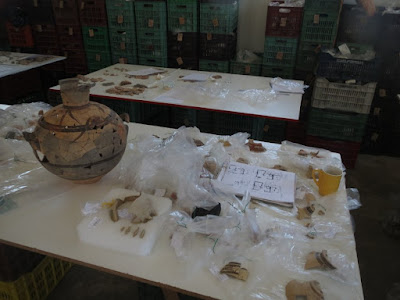To see in person what our current archaeological projects with a fieldwork permit from the Ministry of Culture and Sport are doing Jonathan and I (together or separately) visit each one, usually every summer. Last week on Tuesday we journeyed to the Argolid. In the Inochos river valley to the northwest of Argos the Western Argolid Regional Project [WARP] is in their third and final season of intensive pedestrian survey of a 30,000 ha research zone. Dimitri Nakassis (University of Toronto) took us to three sites with good views of the surrounding valley and hilly flanks to assist in explaining the variable distribution of the artifact evidence and which concentrations probably represented "sites" and their probable span of occupation. The recording, management, analysis and display of the resulting large data sets would not be possible without the use of GIS.
We then went to their apotheke in Argos to see the finds. Scott Gallimore (Wilfrid Laurier University) and Sarah James (University of Colorado at Boulder) were working on analyzing the finds from this summer and from the their first year in the field. We had an opportunity to chat with the students assisting with the work. It appears that that the closeness to the major settlement of the region over time, which was always focused on/around Argos, has affected the level and nature of occupation in the valley.Ancient Eleon in eastern Boiotia was our next destination on Wednesday the 15th. As the days were getting much hotter Brendan Burke (University of Victoria) and Bryan Burns (Wellesley College) showed us around the excavation of the hoped-for northern end of the Blue Stone Structure. This was a rectangular enclosure constructed in LH I to delimit the area where a series of burials in cist graves were inserted. After its use a low tumulus of earth was formed over it to mark the location. Certainly in the 14th through 12th centuries BC this area was respected and later structures were not built on it. The number of new walls being revealed around this enclosure is impressive. Their ongoing work at the site as part of the Eastern Boeotia Archaeological Project [EBAP] is a synergasia with Dr. Alexandra Harami the Director of the Ephorate of Antiquities of Boiotia.
Just below the akropolis at Eleon on the edge of the village of Arma EBAP uses a building for the conservation, study and drawing of the ceramics found in the excavation. Bartek Lis and Trevor Van Damme gave us an indepth presentation of the different Mycenaean and imported ceramics that have come from the Northwest and Southwest sectors as well as the Archaic/Classical votive materials from the Southwest Sector. The quality of these vessels from domestic contexts dating mainly to LH IIIA2 and LH IIIC is impressive. I enjoyed seeing my former student at Brock, Tina Ross, as she is the principal artifact illustrator for the project.
Finally, this past Wednesday I made a "surgical strike" on the Stelida-Naxos Archaeological Project's [SNAP] excavations on the lovely island of Naxos. In the 3+ hours that I had before boarding the boat back to Piraeus Tristan Carter (McMaster University) showed me all of this year's and last year's test trenches on the western side of the steep hill of Stelida along with the fossilized dune deposits on the shoreline. In the walkabout I was, thus, able to talk with all of the hardy diggers who are toiling away in the hot sun. The excavation has documented the exploitation of the massive quartzite outcrop that is the core of the hill from at least the end of the Lower Palaeolithic through the Mesolithic periods. The excavation phase of the project is a synergasia with Dr. Demetrios Athanssoulis, the Director of the Ephorate of Antiquities of the Cyclades.The depth of the sediments on the hillside and the various geomorphological processes that created the complex stratigraphy revealed by the sondages is an eye-opener. The sheer quantity of quarrying debris, cores and tool preforms that is spread all over the slopes is amazing. The team is hoping to find in situ cultural strata so they can employ various scientific dating techniques that will give them absolute dates BP for the different cultural horizons seen in the chipped stone material that has been recovered.
In early July I will fly up to Thessaloniki from Crete so that I can visit our excavations at ancient Argilos near Amphipolis. Stay tuned for my reactions to their very interesting finds!
Each of our fieldwork projects will submit a guest blog on aspects of their summer's work for posting during our annual recess in August. CIG is always close to you!
Cordially,
David Rupp
Director








No comments:
Post a Comment